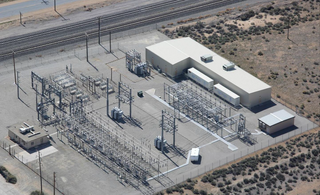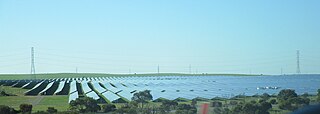
Solar power in Australia is a fast growing industry. As of September 2021, Australia's over 2.96 million solar PV installations had a combined capacity of 23,466 MW photovoltaic (PV) solar power, of which at least 4,117 MW were installed in the preceding 12 months. In 2019, 59 solar PV projects with a combined capacity of 2,881 MW were either under construction, constructed or due to start construction having reached financial closure. Solar accounted for 9.9% of Australia's total electrical energy production in 2020.
Project EnergyConnect is a proposed electricity transmission line connecting the South Australia and New South Wales districts of the National Electricity Market in Australia. Riverlink was a previous working title for the project, drawn from a proposal first raised in 1999. The Australian Energy Market Operator used RiverLink in its proposal for this interconnector, but the transmission companies in South Australia (ElectraNet) and New South Wales (TransGrid) now call it EnergyConnect.

Lake Bonney Wind Farm, in South Australia, was built in three stages. Stage 1 comprises 46 turbines each having a rated capacity of 1.75 MW and was finished in March 2005. Construction of Stage 2 began in November 2006 and was finished around April 2008. Stage 2 comprises 53 turbines of 3 MW. Stage 3 comprises 13 turbines of 3 MW of total 39 MW). Stage 3 construction commenced in February 2009 and was commissioned in September 2009.
South Australia has a variety of natural energy sources. It contains significant reserves of fossil fuels such as natural gas, coal, and oil – although there are incentives to phase these out in favour of clean energy. The state also contains large amounts of uranium, including the world's single biggest deposit at Olympic Dam, which represents 30% of the world's total resource. There are also expanses of land suitable for solar and wind farms, and rocks with potential for geothermal energy.

A battery storage power station is a type of energy storage power station that uses a group of batteries to store electrical energy. Battery storage is the fastest responding dispatchable source of power on grids, and it is used to stabilise grids, as battery storage can transition from standby to full power within milliseconds to deal with grid failures.
Kennedy Energy Park is a wind, solar and storage hybrid power station approximately 20 km south east of Hughenden and 290 km southwest of Townsville in Queensland.
The Hornsdale Wind Farm is an electricity generator in the locality of Hornsdale in the south-west of the Narien Range, north of Jamestown, South Australia. It consists of 99 wind turbines with a generation capacity of 315 megawatts (422,000 hp). The plant is owned and operated by Neoen, a French renewable energy company.
The Bungala Solar Power Project is a solar power farm in Emeroo and Wami Kata near Port Augusta in South Australia. The first stage was connected to the grid in May 2018, and the second stage was connected to the grid in early November 2018. The project gradually reached full power in 2020.
Hornsdale Power Reserve is a 150MW/194MWh grid-connected energy storage system owned by Neoen co-located with the Hornsdale Wind Farm in the Mid North region of South Australia, also owned by Neoen.
The Lincoln Gap Wind Farm is a wind farm under construction in the vicinity of Lincoln Gap on northeastern Eyre Peninsula in South Australia, Australia. It is proposed to consist of 59 wind turbines and generate a total of 212 MW of electricity. Construction began in late 2017 and was initially expected to be commissioned in late 2018. Construction was delayed in July 2018 when unexploded ordnance was discovered on the site, left from historic military testing. The site is not far from the Cultana Training Area.

The Tailem Bend Solar Power Project is a solar power farm near Tailem Bend in South Australia. It has 108MW of generation capacity but is limited to supplying 95MW to the national grid. An additional 85MW is proposed in stage 2. It is developed and owned by Singapore-based Vena Energy, a new name for the former Equis Energy following acquisition by Global Infrastructure Partners in January 2018. The output will be sold to Snowy Hydro for retail sale under its Lumo Energy brand. Stage 2 is also expected to provide battery storage.
Solar River Project is a proposed photovoltaic power station planned to be built near Robertstown in South Australia. It received development approval from the government of South Australia in June 2018 and was expected to start construction early in 2019. The company developing it is based at the University of Adelaide's venture incubator, ThincLab. The project has the support of the Ngadjuri people and the Regional Council of Goyder.
The Dalrymple ESCRI battery is a 30 MW / 8 MW·h grid-connected battery array near Stansbury on Yorke Peninsula in South Australia. Its role is to provide improved reliability and stability to the electricity network on Yorke Peninsula and South Australia.
Limondale Solar Farm is a solar farm south of Balranald in southwestern New South Wales, Australia. When it was completed, it was the largest solar farm in Australia. It is owned by German company RWE through a subsidiary Belectric Solar and Battery, and was constructed by Australian engineering company Downer Group.
The Tesla Megapack is large-scale rechargeable lithium-ion battery stationary energy storage product, intended for use at battery storage power stations, manufactured by Tesla Energy, the clean energy subsidiary of Tesla, Inc.
The Port Augusta Renewable Energy Park is a combined wind and solar farm under construction south of Port Augusta in South Australia, Australia. The solar farm is planned to be at the northern end of the site, west of the Augusta Highway and south of Sundrop Farms. The wind turbines will be on both sides of the Augusta Highway, extending south as far as the road to Horrocks Pass. Construction formally started in October 2020 and is estimated to take about 18 months to complete. The total site is about 5,400 hectares.




